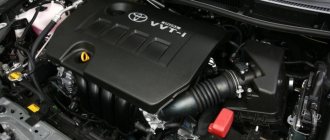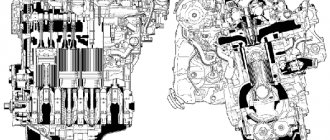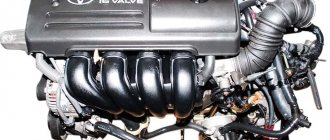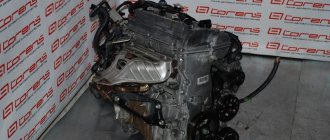Diesel engine in RAV4
In Russia, diesel cars are always spoken of with due respect by people who often travel a lot by personal transport.
This is due to low fuel consumption, good traction and reliability of the machine.
However, when it comes to directly purchasing a new vehicle, most Russians still prefer gasoline options, since they are much cheaper.
In addition, the quality of diesel fuel at Russian gas stations leaves much to be desired.
If we consider a new diesel car from the point of view of maintenance costs, it will cost 15% more. But this figure will be reduced by fuel, which the car consumes more economically than gasoline.
The appearance of a diesel unit is almost no different from a gasoline one. Therefore, first of all, car enthusiasts pay attention to the technical characteristics when purchasing.
In this review we will analyze all the advantages and disadvantages of the diesel RAV 4.
Technical characteristics of Toyota RAV4
The car is equipped with a 2.2 liter 150-horsepower 2AD-GHV turbodiesel and all-wheel drive. Horsepower - 150. Manufacturers assure that there will be no problems during operation if you bring the car to the service station in a timely manner. The service mileage is the same as for gasoline engines - 10,000 km. Starts with the Stop/Start button.
In order for the car to always be in working order, it is necessary to change the oil on time, take care of the turbine, and fill only with high-quality fuel from trusted stores. In this case, the engine life will be more than several hundred kilometers without repair.
Not all drivers like diesel cars because they have characteristic sounds when the engine is running. Sometimes this is even mistaken for a defect.
Manufacturers assure that engine noise will penetrate into the cabin only at idle speed. On the go, this drawback will not be noticeable.
Along with the 2.2 liter engine, the car was equipped with a 6-speed automatic transmission. While driving, gear shifting is as smooth as possible, and the gear engaged is easy to track using the large tachometer needle on the instrument panel.
Having studied the technical data sheet of the car, you can understand that acceleration to 100 km occurs in 10 seconds. Of course, there are faster vehicles, but you can’t tell from the sensations that it takes a long time to gain speed. When switching to higher gears, the vehicle does not lose acceleration dynamics. This is especially noticeable on the track.
If a car enthusiast is accustomed to quickly overtaking on the road, then the car’s traction will be quite enough for him.
A car with these characteristics is suitable for drivers who move in an urban environment and those who travel long distances.
The suspension of the car in question is no different from the petrol version and is worthy of praise. By car you can easily drive over small and significant bumps, speed bumps, and various junctions on the road. It takes serious impacts to break through the suspension.
In addition to the “Drive” mode, the box is equipped with “Sport” and “ECO” modes. Car users claim that there are no significant differences between them. A decrease in fuel consumption can only be noticed if you drive long distances. In sport mode the engine will rev up. But these changes cannot be called cardinal.
Toyota Rav4 in everyday life
The enormous difference between the fourth generation and its predecessors is the dimensions and geometry of the interior. It’s not that it was cramped and tight before, but in this generation it has surpassed both itself and many competitors like the Ford Kuga. The rear sofa provides a generous amount of space for all three passengers, and the trunk (500+ liters), although it suffered from the transfer of the spare tire from the fifth door under the floor, still accepts long items and large cargo.
And all sorts of little things too. Following the example of older comrades like Audi, this Rav4 received a bunch of accessories for the trunk such as nets and guides/limiters. Everything works together to ensure that oversized items do not fly around the trunk from wall to wall, but are securely fixed.
In terms of options, the restyled versions are cooler and more packaged than the earlier copies. They have an advanced surround view system that draws a beautiful 3D projection of the car and surroundings, allowing you to see all the blind spots on the screen. They are, of course, poorly drawn, because the camera resolution is low, and it’s hardly worth pursuing such options.
Advantages of Toyota RAV4 diesel
The advantage of the Toyota RAV4 with a diesel engine (compared to a gasoline engine) has already been described - greater savings on fuel. But a modern car is also equipped with many useful devices that make driving easier:
- Navigation with integrated modem. Moreover, paid traffic for 1 year will be automatically included in the price of the car.
- The driver gets the opportunity to view the weather forecast, use an Internet browser, use music and other useful services, which are combined with a graphical interface. You can use applications through voice control, which greatly simplifies driving, since the driver does not have to be distracted.
- Using multimedia functions, a car enthusiast can quickly monitor traffic jams and create the optimal route. These features have safety implications because the driver won't have to look at his cell phone to get the data he needs. The function is useful for residents of megacities.
- Another advantage of the car is its affordable price compared to its competitors. The driver does not have to deprive himself of comfort while traveling. A diesel crossover in full Comfort configuration costs 2,500,000 rubles. For the same car, the “Prestige” version will have to pay 2,189,000 rubles.
Gasoline modifications have better models (2014, 2021, 2017), but they cost more than diesel ones, although they differ slightly from them in terms of comfort.
Disadvantages of Toyota RAV 4 diesel - according to owner reviews
The main disadvantages that Toyota RAV4 users notice:
- A not particularly serious drawback that worries drivers is the inconvenient placement of the buttons on the steering wheel. This causes some discomfort when moving. If desired, the car owner can rearrange them himself, but this will require additional money and effort.
- Full navigator functions will be available only in maximum trim levels. But the most necessary features can be used on all modifications.
- Some users note that the upholstery is not of high enough quality for the car’s price of 2 million rubles. Owners often report that the leather on the seats where they come into contact with the seat belts wears off quite quickly.
- Many users on sites with reviews of the 2019 Toyota RAV 4 diesel claim that manufacturers saved a lot on LEDs. At night many buttons are not visible. The problem is quite serious, because while searching for the switch, the driver is distracted from the road and may get into an accident.
- Not the strongest windshield when compared to competitors.
On websites with reviews of Toyota RAV 4 diesel owners, people note that the car is very reliable, economical and easy to operate. Serious problems are rare.
Review from the owner of the car New Toyota RAV 4 2021 diesel 2015
Author:KimModel: New Toyota RAV 4 2021 diesel Year of manufacture: 2015 Fuel consumption: up to 13 liters
- Those. characteristics
- Other reviews
- Sale
- Crash test results
Advantages:
modern design, spacious interior, rich equipment, all-wheel drive, high-quality finishing materials.
Disadvantages:
stiff suspension, short rebound travel of the front struts, inadequate spare wheel, noisy engine, poor placement of some buttons.
Review:
You can say that I am monogamous. At least regarding cars. Apart from my first car which was a VAZ eight, I only had Toyotas, it just so happened. Before RAFIK there was Kamryukha. Until the Camry Corolla. In general, ten cars in descending order by class or age. RAV is not only my first SUV. It was also the first car on which I consulted abroad. We went to see our brother-in-law in Germany. I looked at what cars they preferred there. I don't mean the brand. Diesel, that's their preference. More mechanics. But this is too much. After so many years of operating cars with automatic transmissions, this would be overkill. A heavy fuel Pradika would be great. But taking into account financial possibilities, we chose RAV. I never thought Toyotas were beautiful; a lot of cars are prettier. This is not happiness. The main advantage is technical characteristics and reliability. However, I think the new RAFIC is more than competitive in this category too. Apparently due to deliberately narrow optics and original body elements, grille shapes and the shape of the rear door. The result is an aggressive, stylish, sporty look. I would even say very close to a premium Lexus. By the way, the optics are all LED, at least in our configuration. We chose Elegance. And DRL and LCD low and high beams, not to mention the taillights. Of course, it looks cooler on eighteen-wheelers, but the ride on plumper tires is more comfortable, in my opinion. I’ll immediately note that the chassis is quite rigid. Potholes in the asphalt are quite harsh on the fifth point. The Camry is definitely softer. In addition, the front suspension is a bit short on rebound. Even a medium-sized policeman, if the speed is not slowed down, produces an unpleasant bang. But in turns the tall car practically does not root. I have a feeling that the designers wanted to give the crossover car-like habits. Indeed, the car drives like a car. It maintains its trajectory clearly and requires almost no steering at speed. True, the steering wheel is a bit heavy at parking speeds. But at medium and high speeds it is a pleasure to drive. You could say that this is nitpicking. An inexperienced driver is unlikely to notice this. But on a slippery winter road, respect to the car. The drive is fully plug-in. But the most important thing is that part of the torque is transmitted back even with a slight turn of the steering wheel. It just feels reliable. And you can only catch the physics of the process from the monitor. The display between the tachometer and speedometer shows how the torque is distributed. Pressed down on the straight line - the entire load was on the front axle. When entering a turn, you can see how part of the traction goes to the rear wheels. You can lock the center differential. Then the moment will be distributed 50/50. This is at speeds up to 40 km/h. I tried it, and according to the manual, you can mix in dirt. It’s possible, but in the process it’s not a strong point. For loose snow, the normal mode is sufficient. But the geometry, in my opinion, is not ideal for a crossover. Ground clearance is 197mm, not an outstanding size. And the overhangs are very large. Nevertheless, after the Camry, cross-country ability is certainly better. There are assistants for climbing uphill and downhill, useful functions. There is a Sport mode and an ECO mode. Very subtle differences, I must say. The response to pressing the accelerator changes. Either smoother or sharper. Basically the box mode changes. The transmission is a classic 6-speed automatic. Very smooth, clear shifts without jerking, freezing or jamming. The engine is elastic and high-torque. There is no sport in my character, but I have enough confidence to start and overtake on the track. The consumption really did not live up to expectations. In the city up to 12-13 liters. In the mixed cycle 9.5-9.9 liters. This is computer data on short runs. Doesn't work as advertised at all. Anyway. We can say that the first experience of owning a diesel car was successful. True, there is a feeling that the car is picky about fuel. Therefore, I only fill up at proven gas stations. The set is greasy. There is everything you need. There is no point in listing everything. But I will note something. In addition to the standard heated front seats and rear window, there is heated windshield, washer nozzles and steering wheel. It helps a lot in winter. In our configuration, the fabric interior seems more practical to me than the leather one. Convenient display on the center console. Two-zone climate. Cruise control. The rear view camera is true with static markings. The salon is spacious. There is more than enough space both front and rear. The finish is nice. There are many soft elements and leather inserts. The trunk is roomy. But to some extent thanks to the dokatka. A full wheel would be better. The back row of the rear row folds almost into a flat floor and is adjustable in angle. Front seats with good lateral support. Sound insulation is generally good. The wind and wheels are not a nuisance, and the engine is quite loud when accelerating. There are minor ergonomic flaws. For example, I don’t really like the placement of the buttons for the heated glass, seats and connectors. There are no paddle shifters. So if you want to play with manual control of the box, then only with the lever. Overall I'm happy with the car. Let's assume that the first crossover with a diesel engine in my experience lived up to expectations.
Add your review
Review score - 2.99
Viewed 23296 times 30 people voted
Common car problems and their solutions
The Toyota RAV4 with a diesel engine has a drawback that most drivers notice - poor sound insulation.
To solve the problem, you will have to take the car to the dealership or disassemble the body yourself to replace the inner layer.
Another weak part of the car is the paintwork (the bumper especially suffers).
Car enthusiasts claim that the quality of the paint leaves much to be desired, and therefore chips quickly appear on the body.
There is only one solution to this problem - replacing the failed part of the car.
Having familiarized yourself with the problems, pros and cons from owner reviews of the RAV 4 diesel, you need to decide whether the advantages of the vehicle outweigh its disadvantages.
Nominal and actual motor life
A timing chain is used as a timing drive in all crossover gasoline engines. Its service life is noticeably higher than that of other representatives of this car segment - 150 thousand km. Owners of Rav 4 note that after this mark its stretching begins, therefore, it is not recommended to operate the car on the same chain for longer than 150,000 km. With high-quality and timely maintenance, the two-liter naturally aspirated 1AZ-FE engine covers at least 300 thousand km. Cases when this engine traveled 400 and even 500 thousand kilometers are not isolated. There is considerable potential in this modification of the power plant.
Another 2.0-liter naturally aspirated engine, the 3S-FE, has approximately the same resource. This is a fairly reliable power unit, an exact copy of the 2.2-liter engine from the Toyota Camry, but with one difference - it does not have balance shafts. The motor works perfectly on the AI-92, its valves do not suffer in the event of a timing drive break. Along with the drive, the roller and pump are also replaced. The main thing is to respond to the slightest malfunction in a timely manner, as well as replace consumables with high-quality analogues or original parts.
The 2.2-liter AD-FTV turbodiesel is equipped with a belt drive. As a rule, the engine does not cause any special problems during the first 250-280 thousand kilometers. Afterwards, you may need to replace the injectors, which are seriously affected by low-quality fuel. Often, owners have to clean the VRV and EGR vacuum valve ahead of schedule. In some cases, these elements fail prematurely. Replacing them costs 30-50 thousand rubles. Potentially, the 2.2-liter engine is capable of traveling 300 thousand km on Russian roads. To extend the service life of the unit, it is recommended to clean the injectors every 10-15 thousand kilometers.










